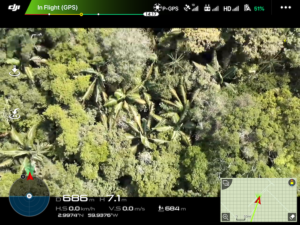 Thanks to drone research, scientists can eavesdrop about what plants in the Amazon have to say about climate change – a conversation that could affect every ecosystem on earth.
Thanks to drone research, scientists can eavesdrop about what plants in the Amazon have to say about climate change – a conversation that could affect every ecosystem on earth.
Researchers with Harvard’s John A. Paulson School of Engineering and Applied Sciences recently published findings in the Proceedings of the National Academy of Sciences showing how drones can detect special chemical signals emitted by plants in the fragile forests of the Amazon.
Known as volatile organic compounds, the chemicals tell a fascinating story about ecosystem health in the face of human-caused deforestation and climate-change stress factors.
VOC signatures are much like fingerprints (or perhaps Twitter posts would be a more modern analogy).
Unique to each plant species, the signals allow flora to “communicate” with other species of plants and animals.
And like human tweets, they change minute by minute in response to outside events; but in the case of plants, the signals are less about Taylor Swift’s latest hit and more about drought and flooding.
In the past, VOC signatures could only be detected using cumbersome platform towers staged above the forest canopy.
In addition to being dangerous for data collectors, erecting the towers is an invasive process and can lead to compromised data.
“The Amazon contains thousands of small ecosystems, each with their own biodiversity and VOC signals,” said Jianhuai Ye, a postdoctoral fellow at SEAS.
“Yet, there are less than 10 of these towers in the entire forest and they are all built in similar ecosystems where the soil can support large structures. As you can imagine, this leads to a lot of bias in the data.”
Led by Harvard engineering professor Scot Martin, the project began last summer. The research team launched customized drones to gather data on the biological signals from two nearby ecosystems in central Amazonia.
Researchers were surprised that – contrary to expectations — the ecosystems didn’t share the same emissions. Drone flights that a chemical called isoprene emitted a 50 percent higher concentration in a plateau forest when compared to a nearby sloped forest.
It turned out the emissions could vary by 100 to 200 percent among the various ecosystems – data previous studies had missed.
“This research highlights how little we understood forest heterogeneity,” Martin said.
“But drone-assisted technologies can help us understand and quantify VOC emissions in different, nearby ecosystems in order to better represent them in climate and air quality model simulations.”
Jason is a longstanding contributor to DroneLife with an avid interest in all things tech. He focuses on anti-drone technologies and the public safety sector; police, fire, and search and rescue.
Beginning his career as a journalist in 1996, Jason has since written and edited thousands of engaging news articles, blog posts, press releases and online content.
Email Jason
TWITTER:@JasonPReagan
Subscribe to DroneLife here.







[…] Source link […]